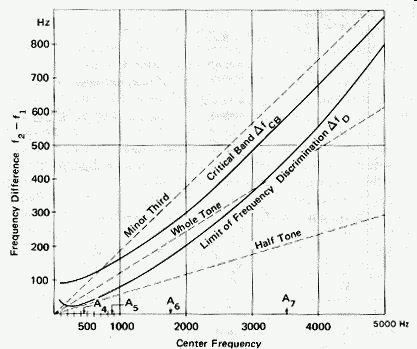critical band
A range of frequency ratios which is less than a minor third across much of the audible spectrum, but considerably wider in the lower registers. If the interval between two pure tones is greater than a critical band, there will be no roughness in the sensation; as the interval is further decreased the roughness will at first increase, then the notes will sound like they are fusing into one rough sound; then the sensation will be of one tone of varying amplitute (beating); then the roughness will decrease as the rate of beating decreases, slowing down to zero as the interval approaches unison.
A range of frequency ratios which sweeps across the audible spectrum in a band, within which two notes will sound like they are fusing into one rough sound.
The limits for pitch discrimination and the critical band depend strongly on the center frequency (the average frequency of the two tone stimuli). They are both relatively independent of amplitude, but may vary considerably from individual to individual.
The critical band is related to several psychoacoustical phenomena. The following figure shows the dependence of pitch discrimination and critical band with the center frequency of the component tones.

The tonalsoft.com website is almost entirely the work of one person: me, Joe Monzo. Please reward me for my knowledge and effort by choosing your preferred level of financial support. Thank you.
